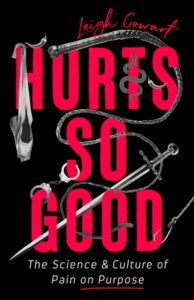
Centuries Before Fifty Shades, A Runaway Hit About Kinky Sex
Leigh Cowart on the Success of Sadomasochistic Books from 1800s Russia to the Present
In 2009, an aspiring writer posted a novel’s worth of steamy, Twilight-based drama to FanFiction.net, under the nom de plume Snowqueens Icedragon. For those of you not familiar, fan fiction (or fanfic) is a massive field of online literature where fans contribute to their favorite fictional universes with all manner of writing, much of it dripping with sexual content not available in the originals.
Snowqueens Icedragon’s work was an explicit retelling of Stephanie Meyer’s teenage vampire smash. It featured Bella Swan and her ageless paramour, Edward Cullen, in a variety of X-rated scenarios. It was, in no uncertain terms, a wild success, becoming a widely read companion to Meyer’s more chaste saga of longing, denial, and romance. But success in such a forum was not to last.
By the time the story was booted by the fan fiction megasite for its sexual content—which is technically verboten, though the rule is widely flouted—the titillating story of BDSM Twilight had already racked up over 37,000 reader reviews. With the winds of a new fan base now filling her sails, the author moved the story over to her personal website.
Soon after, she performed a little trick that’s known in publishing as filing off the serial numbers, removing from the manuscript all references to her sexy, hematophagous source material. With a few name changes, the work became legally ready to sell on the open market: Bella became Anastasia, Edward became Christian, and Snowqueens Icedragon’s “Masters of the Universe” became E. L. James’s Fifty Shades of Grey trilogy.
You probably know where I’m going with this.
Erika Leonard, the London television executive behind the now ubiquitous pen name, was about to get a rather large pay raise. From 2010 to 2019, the first book in the series sold an astounding 15.2 million copies in the United States, making it the best-selling book of the decade. And it wasn’t just the initial, eponymous book that did well: slots two and three on the decade’s top 10 list were filled by the second and third books in the series, Fifty Shades Darker and Fifty Shades Freed, respectively. The NPD Group, a market research company, reported that the trilogy sold nearly 35 million print and e-books in the United States, in that decade alone.
On its home turf of the United Kingdom, Fifty Shades of Grey became the fastest-selling adult novel of all time. It has been translated into fifty-two languages. There have been three major motion picture adaptations of the books, which were commercially successful, though, like their borrowed source material, near universally panned by movie critics. RottenTomatoes.com, a movie review aggregator that assigns meta scores based on multiple reviews, gave Fifty Shades of Grey a dismal “25% Fresh” rating from the critics. The other two movies? The second scored an impossibly low 11 percent, the last sliding in at 12 percent.
It wasn’t just the movies that were despised: the critics absolutely loathed the books too, saying that “James writes as though she’s late for a meeting with a sex scene” (Zoe Williams, The Guardian), and “compared to the other incredibly problematic aspects, the poor writing in Fifty Shades is almost welcome” (Marama Whyte, Hypable), and “if Jane Austen . . . came back to life and read this book, she would kill herself” (Dave Barry, Time magazine).
But the readers? The readers ate it up. Society was coming into the age of the e-book, which made it easier for people to stealthily read the BDSM fantasy that, suddenly, everyone was talking about. (Some people even credit the sultry series with propelling the sales of e-book readers so people could read their smut anonymously.) By 2020, James had an estimated net worth of around $150 million.
I bring this up to remind you that humans love, love, love reading about sex. Fifty Shades hit a sweet spot of titillation, Cinderella story corniness, wealth fetish porn, and predigested, quick-reading prose. It took off like fire through sawdust. In spite of significant criticisms that the book misunderstands BDSM as abuse, a lot of people read those fucking books.
This is of great interest to me personally because it demonstrates broad public interest in a very common practice, one that modern Western culture typically considers to be taboo: pain for pleasure. In the book, Ana and Christian explore common tropes of BDSM literature, like relationship contracts, impact play, and the feeling of being overwhelmed by a controlling paramour. With the success of these novels in mind, I ask you to take these little publishing statistics and glimpses into popular desires and place them carefully on a shelf in your memory, just for a moment. We are going back to the Victorian era to witness the runaway success of some other books about kinky sex. I’m going to show you something.
*
In 1836, a boy with quite an outré future ahead of him was born in what is now Lviv, Ukraine, but at the time was a territory of the Austrian Empire called the Kingdom of Galicia. The father, Leopold Johann Nepomuk Ritter von Sacher, was an Austrian civil servant who later went on to become a commissioner of the Imperial Police Force in Lemberg, where they lived. The mother, Charlotte von Masoch, was a Ukrainian noblewoman, and, because of an accident that claimed the life of her brother, she was the last of her royal line. A formidable woman, she convinced her husband to join their names in order to preserve her family lineage. Leopold senior acquiesced. Had he not, you would probably be reading a book about sacherism right now.
Leopold the younger was formed under the redoubtable presence of his parents and was greatly influenced by his beloved nursemaid, a Ukrainian peasant woman named Handzya, who largely raised him. Though he was fond of reading explicit biblical stories of suffering saints and mutilated martyrs, Handzya also regaled Leopold with evocative folktales, stories that often featured cruel, powerful women and elaborate tortures. The settings and characters were usually Slavic, like Handzya. Leopold adored his nanny and later wrote in his journal that he “owed her his soul.”
It was a period of high tensions across the continent. Ten-year-old Leopold and his family fled a peasant revolt in his home city, an event called the Galician Slaughter. In this uprising against serfism, over a thousand aristocrats, landlords, and persons of nobility were murdered, some of them even losing their heads in the street. The imperial response was equally brutal. During this time, baby tween Leo got the hots for his cousin Miroslawa, who impressed him in a jacket trimmed with white fur, her two guns and a dagger dangling from her waist. “On the barricade she was a beautiful Amazon, rifle in hand,” he later recalled. Some people’s childhood fantasies evaporate over time, but not Leopold’s. His fixation on powerful, violent women would persist throughout his life, crystallizing into a lodestone that would draw him ever onward in his quest for his ideal.
His fixation on powerful, violent women would persist throughout his life.
Later, a trip to the Imperial Museum found teenaged Leopold face-to-face with a painting that would change his life. A painting that led to an obsession, that led to a widely celebrated book, that led to a 1967 Velvet Underground hit song (that led to me winning second place in a Hunky Jesus contest with a stigmata nun burlesque act; it’s a wild world out there). The painting that made such a profound impact on this eager teen was by Dutch painter Peter Paul Rubens.
For those trying to place that name, Paul Reubens plays Pee-wee Herman, but the painter Rubens was (and is) the biggest name in the Flemish Baroque movement, melding the aesthetics of Italian Renaissance and Flemish realism for lush, overflowing paintings and dramatically lit flesh. The painting that young Leopold fixated upon was a portrait of the painter’s wife, Helena Fourment. In it, she is luminous and nude but for the furs that drape her. Furs would drape themselves over Leopold’s imagination for the rest of his life. The book he would go on to write, you might have guessed, is Venus in Furs.
By all accounts an exceptionally bright student, Leopold flourished academically and was very diligent in school, studying law in Prague in 1852 at the age of sixteen. He was a big history buff who reveled in tales of torture, martyrs, pillages, and orgies. As his biographer James Cleugh notes in his investigation, “It was now also Leopold found in the Confessions of Rousseau so close a correlative between the fascinations of physical torment and the irritations of concupiscence.” Rousseau was a Swiss philosopher and composer from the previous century who commanded great respect in academic circles and who made no secret of his enjoyment of being spanked by a dominant mother figure. Leopold, in the annals of history at least, had found a kindred spirit.
In 1856, Professor Leopold Sacher-Masoch, now twenty, was lecturing at the Karl Franz University of Graz. He showed promise as an academic but was criticized for making overly dramatic, sweeping statements, which absolutely tracks with what a fussy, dramatic character he was. This police commissioner’s son was clearly rebelling against his father’s crisp mustache generation. Leopold junior always seemed to be in some state of elegant but unkempt dress, with beautiful, too-long hair and a penchant for poetry and sighs full of longing. It was never his lot to adhere to the dictates of the stuffier academics of his day.
So he began writing fiction and after three years was making enough money to resign his academic post and go full-time. With recent advances in printing technologies and rapidly expanding literacy on the Continent, his timing couldn’t have been better. Like a certain London television executive 165 years later, Sacher-Masoch quit his safe day job to become a saucy writer.
What exactly did he write about? Well, lots of things, really. He wrote col- orful, often humorous ethnographic accounts of Slavs and Jews that earned him great respect. His fight against rising anti-Semitism lasted his entire life and made him many friends in Jewish communities. He railed eloquently against wealthy elites (while enjoying all the privileges as the son of wealthy elites) and the destructiveness of war.
However.
What Sacher-Masoch really became known for were his tales of powerful, cruel women. They were almost always of Slavic origin and dominated his work from the very beginning. His biographer writes that in fiction “one could invent one’s own ideal beings, hard-headed but passionate noblewomen, used to authority and fond of it to excess, who stopped at nothing to satisfy their lust for dominion and symbolized it by never leaving off their furs and always having a dog-whip, a horse-whip or a knout within easy reach.” Judging by the tremendous sales of his books, lots of readers shared Sacher-Masoch’s interests. People just really love reading about kinky sex.
Sacher-Masoch’s body of work is extensive and varied, but there is no denying that Venus in Furs launched his career and raised his personal notoriety to another level entirely. Published in 1870, the novella follows the brief and tumultuous affair of deeply romantic Severin von Kusiemski and free-spirited but playfully cynical Wanda von Dunajew. A lot of literary analysis boils the protagonists down to a mushy pulp of one-dimensional characters, but these two are actually quite complex and conflicted. Severin claims to want an ideal, chaste wife—caring, kind, and matronly, just like his dear old mama. (Young Leopold didn’t even try to obscure his mommy issues.)
The lovers sign an explicit slave contract that grants all powers, spiritual and corporeal, over “Gregor,” including the right to murder him if she feels so moved.
However, Severin seems fated to never find this ideal, so he invents another, the evil mirror image of the original—a brutal “tsarina” who will treat him like an animal, like property, who will destroy him utterly if she wishes. Severin is a man obsessed, burning with ethereal visions and grasping eternally at ideals that the material world never manifests for him. Wanda von Dunajew, on the other hand, is out to have a ball:
“No, I forgo nothing, I love any man who appeals to me and I make any man who loves me happy I am rich, and beautiful, and just as I am, I live cheerfully for pleasure and enjoyment.”
Wanda doesn’t live to serve one man nor to destroy many, but Severin is a captivating speaker. He convinces her to try on the ermine mantle of the conqueror for a little while. She lives for experience, and this is certainly a new kind of experience for the lovely libertine. They travel by train to Italy, with Wanda playing her role of cruel, wealthy debutante. Severin poses as her manservant, “Gregor.” He rides third class and fetches her bags for her. You can imagine how exciting this kind of fantasy might be for the author, son of a baroness and an imperial police inspector.
The lovers sign an explicit slave contract that grants all powers, spiritual and corporeal, over “Gregor,” including the right to murder him if she feels so moved. There are explicit beating scenes that would make a Fifty Shades fan blanch. Wanda takes a strapping Greek lover, and together they beat and degrade Severin further. It would be tempting to say that everything’s going Severin’s way, considering this is exactly what he had been clamoring for, but it’s more complicated than that. He is truly tormented by the torments he’s brought upon himself. He can barely contain the jealousy and humiliation burning within him: “The sensation of being whipped before the eyes of a woman one adores by a successful rival is quite indescribable; I was dying of shame and despair.”
“How creative!” you might say. “What an inventive writer!” The thing is, Venus in Furs is almost entirely autobiographical. Sacher-Masoch took that trip to Italy. He posed as “Gregor,” the footman to his lover, one Fanny Pistor Bogdanoff. They dabbled in furs and whips and even took on an Italian actor to play the role of strapping interloper. Prior to Fanny, the dashing young writer had taken up with a married woman in Graz and had convinced her to have a tryst with a bogus “Polish count” who ended up actually being a Russian chemist shop clerk on the lam for robbing the till at his work. It turns out “the Count” had syphilis and gave it to Leopold’s lover, so he ditched her, pretending to be appalled by her treachery. The guy was a fucking mess.
A little later in life, Sacher-Masoch married Aurora Rümelin and spent a decade coercing her into similar scenarios. They also signed a slave contract. He took out personal ads for her to find lovers and refused to continue writing and supporting their family if she did not become the “Wanda” of his fantasies. A woman of that time did not have many options to support herself, especially once she was married and had children. Aurora gave up her name, her former self, and donned the symbolic furs her husband coveted. According to her Confessions of Wanda von Sacher-Masoch, “From then on, not a day passed without my whipping my husband, without proving to him that I was keeping my part of the contract. At the beginning my repugnance was great, but little by little I became used to it, although I never did so other than reluctantly. Seeing that I was doing as he wished, Leopold set out to make the experience as painful as possible. He had whips especially made to order, including one with six lashes studded with sharp nails.”
Studded with nails! Leopold was not fucking around. He is what people in the BDSM scene today would call a serious bottom. He wanted pain; he wanted degradation. And neither one in small measures. And yet, like Severin of Venus in Furs fame, he was always conflicted, never satisfied more than momentarily. The gulf between his mystical ideals and real, fleshy human beings caused Sacher-Masoch and his loved ones endless distress.
And a hot new source of distress was just around the corner.
___________________________________________________

From Hurts So Good: The Science and Culture of Pain on Purpose by Leigh Cowart, copyright © 2021. Reprinted by permission of PublicAffairs, an imprint of Hachette Book Group, Inc.
Leigh Cowart
Leigh Cowart is a researcher and journalist whose work has appeared in the Washington Post, New York Magazine, Buzzfeed News, Hazlitt, Longreads, Vice, and other outlets. Before becoming a journalist, Cowart was immersed in academia, doing research on subjects like sexual dimorphism in leaf-nosed bats, and resource allocation in flowers. They live in Asheville, NC.












